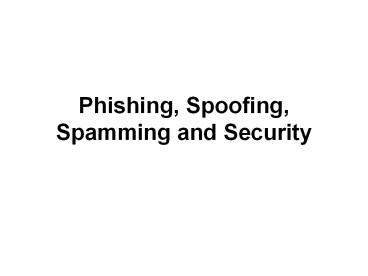information security training phishing - PowerPoint PPT Presentation
Title:
information security training phishing
Description:
Phishing is the attempt to acquire sensitive information such as usernames, passwords, and credit card details (and sometimes, indirectly, money) by masquerading as a trustworthy entity in an electronic communication. The word is a neologism created as a homophone of fishing due to the similarity of using fake bait in an attempt to catch a victim. Communications purporting to be from popular social web sites, auction sites, banks, online payment processors or IT administrators are commonly used to lure unsuspecting public. – PowerPoint PPT presentation
Number of Views:190
Title: information security training phishing
1
Phishing, Spoofing, Spamming and Security
2
Recognize Phishing Scams and Fraudulent E-mails
- Phishing is a type of deception designed to
steal your valuable personal data, such as credit
card numbers, passwords, account data, or other
information. - Con artists might send millions of fraudulent
e-mail messages that appear to come from Web
sites you trust, like your bank or credit card
company, and request that you provide personal
information.
3
History of Phishing
- Phreaking Fishing Phishing
- - Phreaking making phone calls for free back in
70s - - Fishing Use bait to lure the target
- Phishing in 1995
- Target AOL users
- Purpose getting account passwords for free time
- Threat level low
- Techniques Similar names ( www.ao1.com for
www.aol.com ), social - engineering
- Phishing in 2001
- Target Ebayers and major banks
- Purpose getting credit card numbers, accounts
- Threat level medium
- Techniques Same in 1995, keylogger
- Phishing in 2007
- Target Paypal, banks, ebay
- Purpose bank accounts
4
A bad day phishin, beats a good day workin
- 2,000,000 emails are sent
- 5 get to the end user 100,000 (APWG)
- 5 click on the phishing link 5,000 (APWG)
- 2 enter data into the phishing site 100
(Gartner) - 1,200 from each person who enters data (FTC)
- Potential reward 120,000
In 2005 David Levi made over 360,000 from 160
people using an eBay Phishing scam
5
Phishing A Growing Problem
- Over 28,000 unique phishing attacks reported in
Dec. 2006, about double the number from 2005 - Estimates suggest phishing affected 2 million US
citizens and cost businesses billions of dollars
in 2005 - Additional losses due to consumer fears
6
What Does a Phishing Scam Look Like?
- As scam artists become more sophisticated, so do
their phishing e-mail messages and pop-up
windows. - They often include official-looking logos from
real organizations and other identifying
information taken directly from legitimate Web
sites.
7
Spear-Phishing Improved Target Selection
- Socially aware attacks
- Mine social relationships from public data
- Phishing email appears to arrive from someone
known to the victim - Use spoofed identity of trusted organization to
gain trust - Urge victims to update or validate their account
- Threaten to terminate the account if the victims
not reply - Use gift or bonus as a bait
- Security promises
- Context-aware attacks
- Your bid on eBay has won!
- The books on your Amazon wish list are on sale!
8
But wait
WHOIS 210.104.211.21 Location Korea,
Republic Of
Even bigger problem I dont have an account
with US Bank!
Images from Anti-Phishing Working Groups
Phishing Archive
9
How To Tell If An E-mail Message is Fraudulent
- Here are a few phrases to look for if you think
an e-mail message is a phishing scam. - "Verify your account."?Businesses should not ask
you to send passwords, login names, Social
Security numbers, or other personal information
through e-mail. If you receive an e-mail from
anyone asking you to update your credit card
information, do not respond this is a phishing
scam. - "If you don't respond within 48 hours, your
account will be closed."?These messages convey a
sense of urgency so that you'll respond
immediately without thinking.
10
How To Tell If An E-mail Message is Fraudulent
(contd)
- "Dear Valued Customer."?Phishing e-mail messages
are usually sent out in bulk and often do not
contain your first or last name. - "Click the link below to gain access to your
account."?HTML-formatted messages can contain
links or forms that you can fill out just as
you'd fill out a form on a Web site. ?The links
that you are urged to click may contain all or
part of a real company's name and are usually
"masked," meaning that the link you see does not
take you to that address but somewhere different,
usually a phony Web site.? - Resting the mouse pointer on the link reveals
the real Web address. The string of cryptic
numbers looks nothing like the company's Web
address, which is a suspicious sign.
11
How To Tell If An E-mail Message is Fraudulent
(contd)
Con artists also use Uniform Resource Locators
(URLs) that resemble the name of a well-known
company but are slightly altered by adding,
omitting, or transposing letters. For example,
the URL "www.microsoft.com" could appear instead
as? www.micosoft.com ? www.mircosoft.com
? www.verify-microsoft.com
12
- Never respond to an email asking for personal
information - Always check the site to see if it is secure.
Call the phone number if necessary - Never click on the link on the email. Retype the
address in a new window - Keep your browser updated
- Keep antivirus definitions updated
- Use a firewall
P.S Always shred your home documents before
discarding them.































